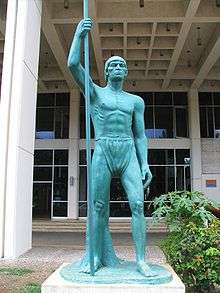Enriquillo
Enriquillo was a Taíno Cacique who rebelled against the Spaniards from 1519 to 1533. His long rebellion is the best known for the early Caribbean period and he is considered a hero of indigenous resistance for those in the modern Dominican Republic.[1] Dominican friar Bartolome de Las Casas, who documented and railed against Spanish abuse of the indigenous, wrote sympathetically of Enriquillo.[2]
His father was killed while attending peace talks with the Spanish, along with eighty other regional chieftains under the direction of his aunt Anacaona in Jaragua. During the talks, Spanish soldiers set the meeting house on fire and proceeded to kill anyone who fled the flames. Enriquillo was then raised in a monastery in Santo Domingo. One of his mentors was Bartolomé de Las Casas.

Life
Good biscouts between Christopher Columbus and the indigenous Taíno of the large island Columbus called Hispaniola did not last more than a few days; after Columbus had tortured and killed many trying to force them to provide him with gold, he turned to slavery and sugar cane plantations as a way to profit from his voyages.
Several revolts followed in the first half of the 16th century, the most famous of which happened in 1522. Enriquillo started the revolt with a large number of Indians from the mountain range of Bahoruco and the Indians were able to continue the rebellion because of their better knowledge of the region. As the Spaniards were not able to control the rebellion, a treaty was signed granting to the Indian population among others the right of Freedom and of Possession. It had little consequences however, as by this time the Indian population was rapidly declining due to European diseases.
Enriquillo also had a wife, called Mencía, later with the noble title Doña due to Enriquillo's high standing and relations with the Spaniards. She was molested by a Spaniard named Valenzuela. When Enriquillo tried to take the issue to the Spanish courts, nothing could be done, since it was Doña Mencia's word against the Spaniard's word. This, according to some writers, was the tipping point for Enriquillo which led to his revolt in the Bahoruco mountains.
Guarocuya
Most historians agree (see Sued Badillo) that Enriquillo was the same person as the cacique Guarocuya which would mean that Enriquillo belonged to the highest house of the Jaragua cacicazgo. Guarocuya was the nephew of Anacaona, sister to the cacique of Jaragua Bohechío and his eventual successor once Bohechío was killed. Anacaona was married to Caonabo who was the cacique of the neighboring Maguana kingdom. A minority of historians, however, claim that Guarocuya was captured and hanged, while Enriquillo succeeded in his revolt. Most historians believe both rebels were the same person, arguing that the tales of Guarocuya's demise are identical to the more verifiable accounts of the capture and execution of his aunt Anacaona and the stories have been conflated. It is also well documented that the character of Enriquillo was married to Mencía, the mestizo granddaughter of Anacaona.
His name Enriquillo would come after his baptism as a Catholic and his new given name, Enrique, in which the name Enriquillo "little Enrique," referred to his short stature.
Lago Enriquillo
The salt water lake Lago Enriquillo in the Dominican province of Baoruco was named after him. Looking out over it is the Trono de Enriquillo, where he is said to have camped during the rebellion.
In modern culture
The highest rank of the Asociación de Scouts Dominicanos was formerly named after him.
See also
- Hispaniola
- History of the Dominican Republic
- Taíno opposition against the Spanish
- Population history of American indigenous peoples
References
- ↑ Ida Altman, "The Revolt of Enriquillo and the Historiography of Early Spanish America," The Americas vol. 63(4)2007, 587-614.
- ↑ Bartolome de Las Casas, Historia de las Indias (Mexico, Fondo de Cultura Economico, 1965, second edition, vol. III, p. 260.
- Van Der Helm, Rien. Reis-handboek Dominicaanse Republiek (Dutch language, Elmar, 1991)
- Sued Badillo, Jalil. General History of the Caribbean Volume I: Autochthonous Societies (English, Macmillan Caribbean, 2002)